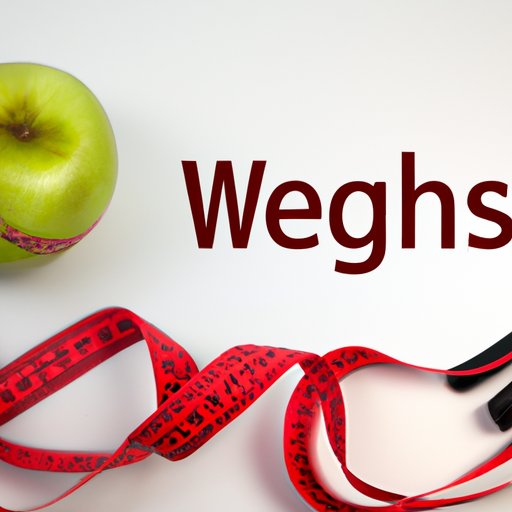
I. Introduction
When trying to lose weight, hitting a plateau is a common occurrence. It’s a time when your weight loss stalls, and you don’t see as much progress as you did before. While frustrating, it’s essential to understand how long a weight loss plateau lasts to stay motivated and continue working towards your goals. In this article, we’ll dive into how many weeks are considered a weight loss plateau and provide tips for overcoming and breaking through the stall.

II. The Science Behind Weight Loss Plateaus
Before diving into how to overcome a weight loss plateau, it’s crucial to understand why it happens. When we lose weight, we create a calorie deficit where we burn more calories than we consume, leading to weight loss. However, as we lose weight, our bodies adapt to the changes, and the weight loss slows down or eventually stops altogether. This metabolic adaptation occurs because our bodies become more efficient at burning fewer calories to perform the same activities as before. Along with metabolic adaptation, there are other factors that contribute to a weight loss plateau:
- Decreased physical activity
- Lack of sleep
- Stress
- Genetics
- Hormonal imbalances
III. How to Overcome a Weight Loss Plateau
If you’re experiencing a weight loss plateau, it’s essential to have patience and persistence. Here are some strategies that might help you overcome the stall:
1. Adjusting Calorie Intake
One of the simplest ways to overcome a weight loss plateau is by adjusting your calorie intake. Consuming too many calories can stall your weight loss progress, while not consuming enough can harm your energy levels and overall health. To determine your ideal calorie intake, first, calculate your resting metabolic rate (RMR), which is the number of calories your body burns at rest daily. Then, adjust your calorie intake accordingly based on your activity levels and weight loss goals.
2. Focusing on Macronutrient Distribution
While calorie intake is essential, focusing on macronutrient distribution can also help overcome a weight loss plateau. Macronutrients, including protein, carbohydrates, and fats, play a significant role in weight loss. Consuming a balanced diet that includes adequate protein, healthy fats, and complex carbohydrates can improve overall health and help you break through the plateau.
3. Incorporating Strength Training
Adding strength training to your workouts can help build muscle mass, which can increase your resting metabolic rate and help burn more calories throughout the day. Strength training exercises include lifting weights, bodyweight exercises, or resistance band workouts.
4. Boosting Metabolism Naturally
In addition to strength training, incorporating metabolism-boosting foods into your diet can help overcome a weight loss plateau. These foods include green tea, hot peppers, and protein-rich foods such as chicken, fish, and lentils.
5. Intermittent Fasting
Intermittent fasting is a dietary approach that involves cycling between periods of fasting and eating. This approach can help reduce calorie intake and improve metabolic health, which can lead to weight loss. However, it is essential to speak to a healthcare provider before attempting intermittent fasting, especially if you have any underlying health conditions.
IV. Tips to Break Through Your Weight Loss Plateau
If you’re still experiencing a weight loss plateau after adjusting your calorie intake and exercise routine, here are some additional tips that might help break through the stall:
1. Increasing Physical Activity
Increasing your physical activity can help break through a weight loss plateau. Instead of sticking to one type of exercise, try a variety of activities like running, cycling, or swimming.
2. Incorporating High-Intensity Interval Training (HIIT)
HIIT is a type of exercise that involves short bursts of high-intensity exercise, followed by periods of rest. This type of training has been shown to improve metabolic health and increase weight loss.
3. Incorporating Resistance Training
Resistance training can help build muscle mass, which can increase your resting metabolic rate and burn more calories throughout the day. Resistance training exercises include lifting weights, bodyweight exercises, or resistance band workouts.
4. Switching Up Your Exercise Routine
Trying new workout routines or exercises can help break through a weight loss plateau. Instead of doing the same exercises every day, mix it up with new activities or workouts.
5. Incorporating Rest and Recovery Days
Rest and recovery days are important to allow your body to recover and build muscle. Taking a rest day can help prevent injury and improve overall health, allowing you to continue working towards your weight loss goals.
V. How to Track Your Progress During a Weight Loss Stall
Tracking progress during a weight loss stall is essential to stay motivated and determine if any adjustments to your diet or exercise routine are needed. Here are some ways to track your progress:
1. Weighing Yourself
Weighing yourself regularly can help track your progress. However, it’s important to remember that weight can fluctuate from day-to-day and may not be an accurate representation of your progress.
2. Taking Measurements
Taking measurements of your body, such as waist, hips, and arms, can help track progress and determine changes in body composition.
3. Body Fat Percentage
Measuring body fat percentage can provide a more accurate representation of progress compared to weighing yourself. There are methods to measure body fat percentage, including skinfold calipers and bioelectrical impedance analysis.
4. Progress Photos
Taking progress photos throughout your weight loss journey can help track progress and show physical changes in your body.
5. Fitness Tests
Taking fitness tests, such as a timed run or push-up test, can help track progress in physical fitness and overall health.
VI. Plateau Busters: Exercises to Boost Fat Loss
Adding specific exercises to your workout routine can help break through a weight loss plateau. Here are some exercises that can boost fat loss:
1. Squats and Lunges
Squats and lunges are compound exercises that target multiple muscle groups and can help build muscle mass.
2. Push-ups and Pull-ups
Push-ups and pull-ups are bodyweight exercises that can help build upper body strength, increase muscle mass, and burn calories.
3. Burpees and Mountain Climbers
Burpees and mountain climbers are high-intensity exercises that target the entire body and can help burn significant calories.
4. Box Jumps and Jump Rope
Box jumps and jump rope are exercises that can help improve cardiovascular health, burn calories, and build muscle mass.
5. Plyometric Movements
Plyometric movements, such as jumping jacks or jump squats, are explosive exercises that can help boost fat loss and improve overall fitness levels.
VII. Psychological Barriers During a Weight Loss Plateau and How to Overcome Them
Psychological barriers can occur during a weight loss plateau, including frustration, boredom, and lack of motivation. Here are some strategies to overcome these barriers:
1. Focusing on Positive Progress
Instead of focusing on the number on the scale, focus on the positive progress you’ve made in terms of healthy habits and lifestyle changes.
2. Changing Your Mindset
Instead of thinking of the plateau as a setback, view it as an opportunity to reassess and adjust your diet and exercise routine to continue making progress towards your goals.
3. Seeking Support from Others
Seeking support from friends, family, or a healthcare professional can provide accountability and motivation during a weight loss plateau.
4. Practicing Stress-Reducing Techniques
Stress can play a significant role in weight loss and can lead to emotional eating and a lack of motivation. Practicing stress-reducing techniques, such as meditation or yoga, can help improve overall well-being and reduce stress levels.
5. Rewarding Yourself
Setting short-term goals and rewarding yourself for meeting them can provide motivation and help overcome a weight loss plateau.
VIII. Foods to Avoid and Include When Hitting a Weight Loss Plateau
When hitting a weight loss plateau, certain foods can sabotage your progress, while others can help break through the stall. Here are some foods to avoid and include when hitting a weight loss plateau:
1. High-Protein Foods
High-protein foods, such as chicken, fish, or lentils, can help increase feelings of fullness and curb cravings, leading to reduced calorie intake and weight loss.
2. Fiber-Rich Foods
Fiber-rich foods, including fruits, vegetables, and whole grains, can help improve digestion and reduce calorie intake, leading to weight loss.
3. Healthy Fats
Healthy fats, such as avocado, nuts, and salmon, can help increase feelings of fullness and improve overall health during a weight loss plateau.
4. Spicy Foods
Spicy foods, such as cayenne pepper or hot sauce, can boost metabolism and increase calorie burn, leading to weight loss.
5. Foods with Metabolism-Boosting Properties
Foods with metabolism-boosting properties, such as green tea or apple cider vinegar, can help increase metabolism and promote weight loss.
IX. Conclusion
In conclusion, a weight loss plateau is a common occurrence when trying to lose weight. While frustrating, understanding how many weeks a weight loss plateau lasts and incorporating strategies to overcome and break through the stall can help you reach your weight loss goals. Remember to track progress, seek support from others, and consult with a healthcare provider before implementing any significant changes to your diet or exercise routine. Keep pushing through the plateau, and remember that progress takes time and patience.




